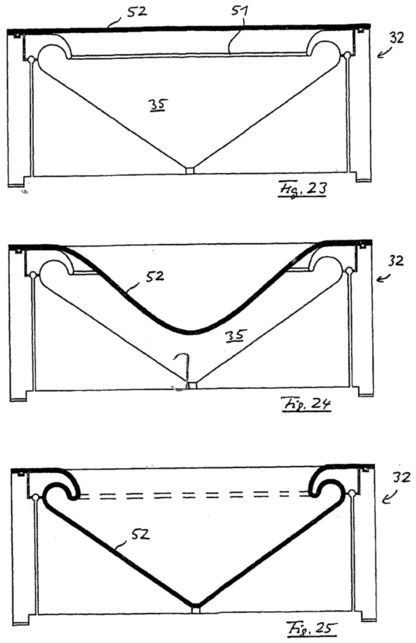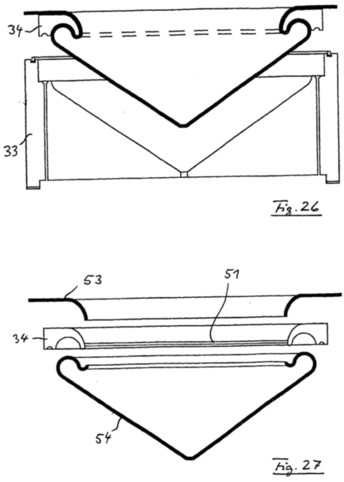It may not
exactly fall under the usual automotive news but a BMW Group
employee was honoured for his solution for a cheap, mobile
device for producing drinking water.
On May 26 in
Brussels, an international jury presented the National Energy
Globe Award 2007 to BMW Group designer Stephan Augustin for
his invention of the so called Watercone, a device for
generating clean drinking water.
Guests at the awards
ceremony included Mikhail Gorbachev, Jose Manuel Barroso, and
Kofi Annan.
The Watercone is a solar-powered cone-shaped desalinator that
generates fresh drinking water from salt or brackish water.
With its rigid outer
skin, this plastic cone can be used floating on water or on
damp ground.
The sunrays shining
on the Watercone cause the water to evaporate under the cone
and condense on the inside of the cone. The droplets of water
then accumulate in a collector trough. The water can be poured
out of the opening at the tip of the Watercone into a
container or drunk directly. The water is purified through the
condensation as if it were undergoing a single-stage
distillation process.
Around 1.6 litres of
drinking water a day can be obtained by using this invention.
This means that the Watercone could play a major part in
solving a number of problems.
UNICEF experts
estimate that 5,000 children still die each day from diarrheal
diseases caused by dirty drinking water. Using the Watercone,
people living in coastal regions in Africa, Asia, and South
America can also obtain drinking water from sea water. In
addition, this device also eliminates heavy metals and other
pollutants when used near rivers.
The Watercone is
made from hard-wearing, unbreakable Bayer Makrolon
polycarbonate with an anti-UV coating and has a guaranteed
working life of at least five years.
The Watercone was
even tested in the BMW wind tunnel showing it could cope with
wind speeds of up to 55 km/h without any problems. This means
that it is largely unaffected by weather.
CARE Deutschland
carried out a pilot project in the coastal town of Zinjibar in
Yemen, where it generally rains only three times a year.
Consequently, the
fishermen have to travel into the interior, sometimes up to 15
km, to find clean drinking water even though they live right
by the sea. CARE handed out 100 Watercones to ten fishermen's
families. The water quality produced was analyzed and found to
be perfect. The people in the village went one further: they
said the drinking water from the Watercone tasted better than
bottled water.
Augustin, an
industrial designer, came up with the idea of the Watercone on
holiday on the Canaries. As he looked across the sea, he
brooded about how to convert the rich stocks of sea water in
the oceans into a daily ration of drinking water.
"I wanted to use my
professional knowledge and my experience to offer people who
suffer from water shortage a humanitarian service in the form
of a practical design", says Augustin.
US7534327 -- Device for
Recovering Drinking Water from Condensate..
Abstract -- A device for recovering
drinking water from condensate consists of a self-supporting
moulded part 11 consisting of a transparent synthetic resin
such as PET or PC, which is resistant to UV radiation. The
moulded part 11 presents an open bottom area 16 with a
collecting channel 15 on the edge side, with the collecting
channel 15 presenting an inner wall 18 oriented towards the
circumferential surface 12 and serving, at the same time, as
floating aid, and with the moulded part 11 being provided with
a pouring opening in its upper section 13. For the manufacture
of this device, a vacuum is created in a special deep-drawing
tool not only in the region of the circumferential surface to
be produced but also in the region of the collecting channel
to be formed, and the moulded part is separated from a
separated deep-drawing tool element outside the zone of the
collecting channel
[0027] FIG. 1
is a perspective side view of a first embodiment of an
inventive device;

[0028] FIG. 2
is a schematic illustration of 4 devices according to FIG. 1,
which are stacked on top of each other;

[0029] FIG. 3
shows another embodiment of the invention for explaining the
principle of operation;
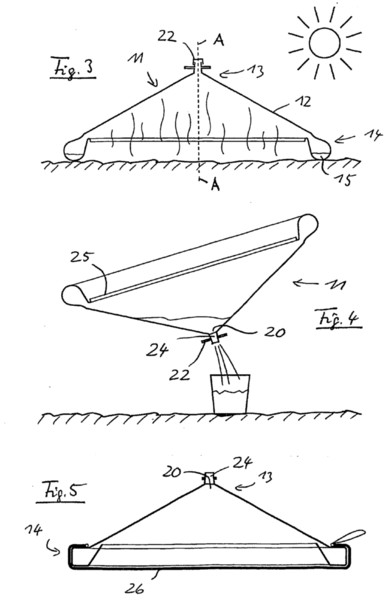
[0030] FIG. 4
illustrates the embodiment according to FIG. 3 in a schematic
section in a condition in which the condensate is poured out;
[0031] FIG. 5
is a view of another embodiment of an inventive device in
which a black cloth permeable to water is stretched over the
bottom area to provide protection from the washing of the
waves and for achieving a greater evaporation heat;
[0032] FIG. 6
shows a schematic view of a further embodiment of the
invention;
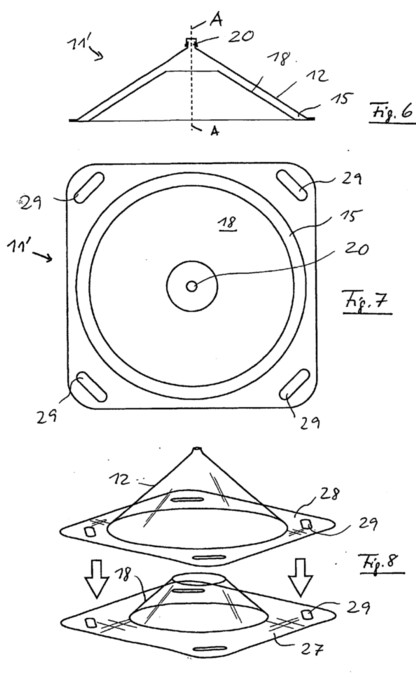
[0033] FIG. 7
is a view of the device according to FIG. 6 from below;
[0034] FIG. 8
is an illustration of the assembly of the device according to
FIG. 6;
[0035] FIGS. 9
to 12 show various embodiments of devices presenting
different geometries of the outside wall;
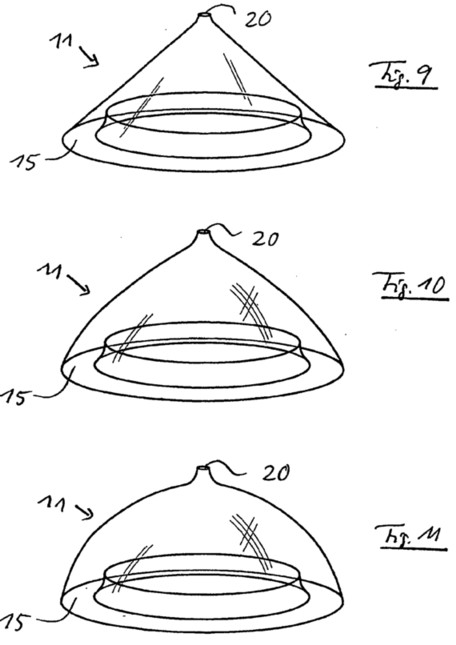
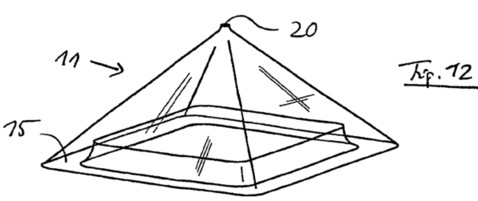
[0036] FIGS. 13
to 15 illustrate a schematic perspective side view, a
view from below and a sectional view along the line XIII-XIII
in FIG. 13;
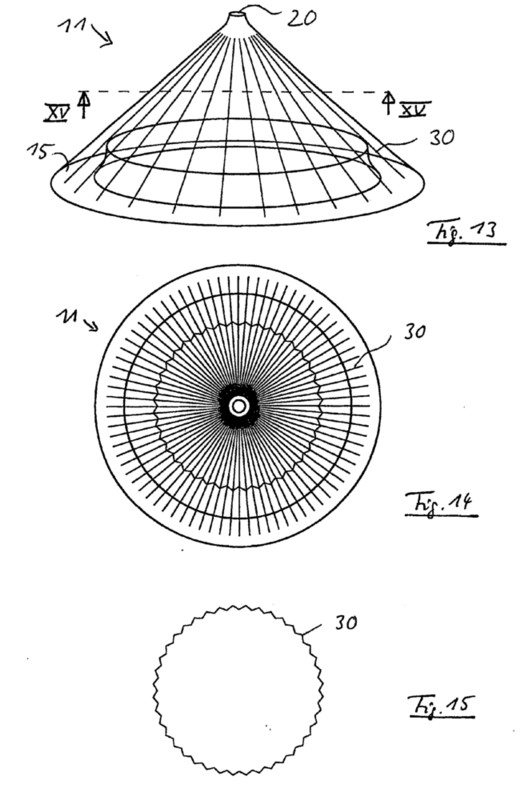
[0037] FIGS. 16
to 18 show various geometries of collecting channels
adapted to be stacked;
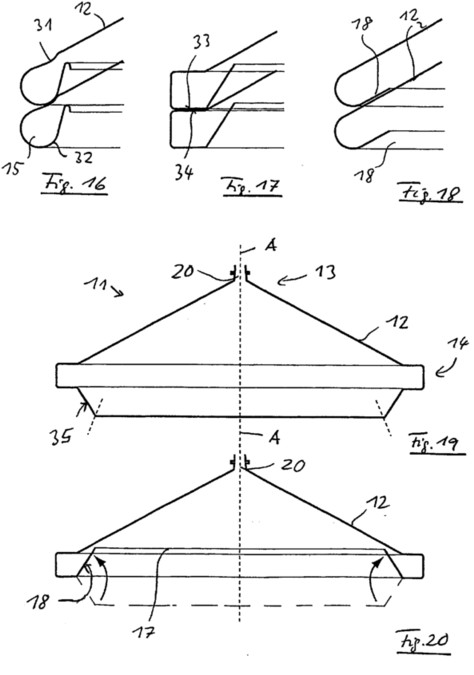
[0038] FIGS. 19
and 20 are schematic views of steps for the manufacture
of an embodiment of an inventive device;
[0039] FIG. 21
shows a schematic sectional view taken through an embodiment
of an inventive deep-drawing tool for the manufacture of a
device presenting rotational symmetry;
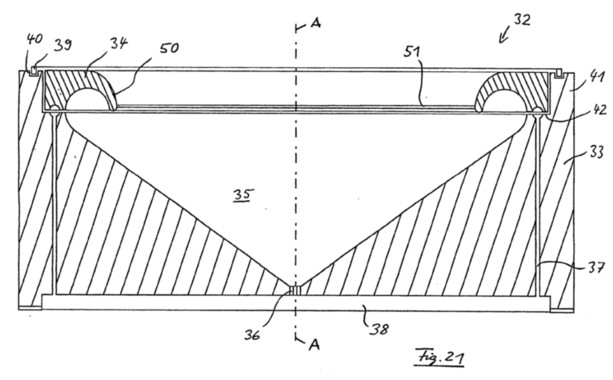
[0040] FIG. 22
is a partial sectional view at an enlarged scale in the upper
left area in FIG. 21 for the illustration of air suction
bores; and
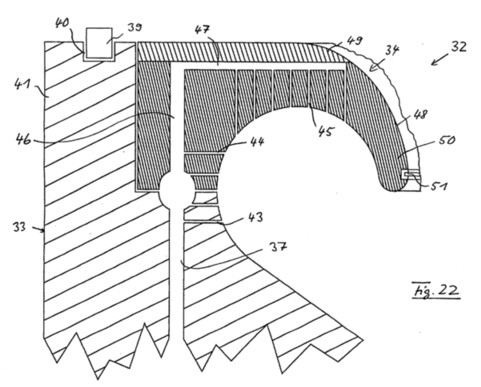
[0041] FIGS. 23
to 27 illustrate individual steps in the manufacture of
one embodiment of the inventive device, using an inventive
deep-drawing tool.
